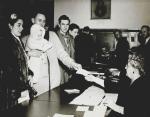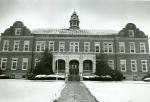Chapter Four: Education and Society Since World War Two
"All Pennsylvanians need true tax reform that provides for a fairer, more reliable funding system for public schools."
-Lancaster Intelligencer- Journal (editorial), May 13, 2007.
In the long half -century following World War II, education became an even more contentious issue for parents, school boards, and policymakers alike. Clashes over curriculum and standards, suitable texts and social values, funding, shifting priorities for rural and urban schools, and the rift between expanding state regulatory authority and local taxpayer discontent all reflected the larger social and political climate in which teaching and learning occur.
The end of World War II ushered in great changes in public and private education across the nation. Passed by Congress in 1944, the Servicemen's Readjustment Act, popularly known as the G.I. Bill, and subsequent legislation for service men and women of other wars paid billions of dollars in college tuition for returning veterans. For the first time in history a whole generation could envision access to affordable college education and entry into the professional class. As student populations swelled and the demand for educational services increased, the era of mass education had dawned, with all of its possibilities and problems.
To meet the challenges, the Commonwealth reorganized its educational bureaucracy. To increase what policymakers called "administrative efficiency," the state reduced the number of public school districts to 501, shifted funding priorities, and embarked on a bold modernization program. By 1969 a new Department of Public Education had jurisdiction over basic and higher education. New programs in vocational and special education expanded the range of services school districts offered. Even as state spending on education increased, however, many Pennsylvania communities faced a waning tax base caused by industrial decline and shifting economic fortunes.
A new culture of professionalism swept through higher education after the war, just as Pennsylvania colleges and universities were coming to grips with the expanding educational franchise. Massive federal funding of technological innovations and defense industries during World War II included development of the first digital computer,
Equally important was the post-war baby boom that peaked in the mid-1960s. To provide television that educated as well as entertained,
This period of dramatic growth and reorganization coincided with an era of progressive social movements that challenged historic barriers to full rights and equal educational opportunity. While allies like
While black students fought for African-American studies in the schools, Pennsylvania branches of the NAACP and other organizations attacked the continued segregation of public schools and inequalities in funding. In Philadelphia, Rev. Leon Sullivan in 1964 founded the
By the late 1960s, women, too, were demanding greater parity in educational and athletic opportunities. Swept up in the liberal reform movement of the 1960s and 1970s, the state and federal governments promoted new standards of educational equity. In 1972, the federal court ruling in PARC v. Pennsylvania ushered in sweeping changes in special education and instructional services to children with intellectual disabilities. Two years later, a Commonwealth Court upheld federal
In the landmark 1985 Pennhurst settlement, the federal courts expanded the Commonwealth's responsibility to assure equal educational rights for all citizens. The 1990 Americans with Disabilities Act also had far-reaching implications for educational inclusion for children and adults with disabilities. From the local school district to the college and university level, educational institutions struggled to make reasonable accommodations in curriculum, learning supports, and accessibility to buildings.
In 2001, the federal No Child Left Behind Act, imposed more stringent standards of "accountability, flexibility, and choice" in educational services to disadvantaged students. Failing to provide the resources necessary to meet more stringent benchmarks, the guidelines became a source of lingering controversy in Pennsylvania schools.
In yet another example of government intervention in an educational controversy, the Dover School District's 2004 proposal to include the teaching of "intelligent design" in its science curriculum set off a national debate about science and religion in the public schools. (In the late 1800s, University of Pennsylvania paleontologist
A 2006 report from the non-partisan Educational Policy and Leadership Council raised critical questions about the future of education in Pennsylvania. Noting a "shortage of technically proficient workers," and a "marked gap between educational attainment for majority and minority populations," the Council called for a dramatic reassessment of secondary and higher education priorities. The report highlighted the need for public education to adjust to the changed economic climate and pressures for workforce development. At the same time, and in another context entirely, the growing controversy over taxpayer support for charter school initiatives, and the popularity of home schooling, signaled new pressures on the Commonwealth's 501 public school districts.
Pennsylvania's current debates about educational priorities are part of a larger discourse about financial accountability and the politics of "entitlement reform." In May 2007 the long-standing conflict between state authority and local taxpayer discontent resurfaced when voters rejected Act 1, which proposed a new formula for school funding that Governor Edward Rendell said also offered property tax relief. The defeat of Act 1 reflected the difficulties of educational and tax reform in a diverse and sometimes divided Commonwealth. Although Pennsylvanians still hold fast to the personal and civic value of education, the expansion in educational opportunities over 250 years has created its own blessings and burdens in William Penn's cherished Commonwealth.














